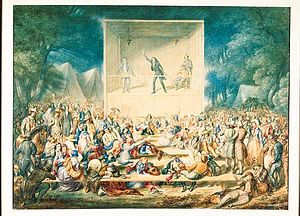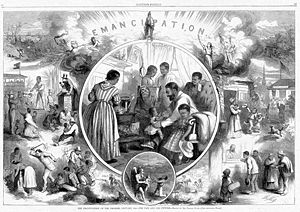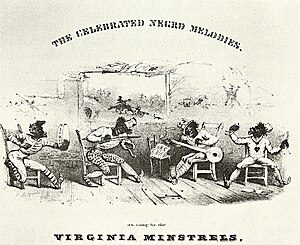
Blues is a music genre and musical form that originated amongst African-Americans in the Deep South of the United States around the 1860s. Blues incorporated spirituals, work songs, field hollers, shouts, chants, and rhymed simple narrative ballads from the African-American culture. The blues form is ubiquitous in jazz, rhythm and blues, and rock and roll, and is characterized by the call-and-response pattern, the blues scale, and specific chord progressions, of which the twelve-bar blues is the most common. Blue notes, usually thirds, fifths or sevenths flattened in pitch, are also an essential part of the sound. Blues shuffles or walking bass reinforce the trance-like rhythm and form a repetitive effect known as the groove.
Jazz is a music genre that originated in the African-American communities of New Orleans, Louisiana, in the late 19th and early 20th centuries, with its roots in blues and ragtime. Since the 1920s Jazz Age, it has been recognized as a major form of musical expression in traditional and popular music. Jazz is characterized by swing and blue notes, complex chords, call and response vocals, polyrhythms and improvisation. Jazz has roots in European harmony and African rhythmic rituals.

Ragtime, also spelled rag-time or rag time, is a musical style that had its peak from the 1890s to 1910s. Its cardinal trait is its syncopated or "ragged" rhythm. Ragtime was popularized during the early 20th century by composers such as Scott Joplin, James Scott and Joseph Lamb. Ragtime pieces are typically composed for and performed on piano, though the genre has been adapted for a variety of instruments and styles.

William Christopher Handy was an American composer and musician who referred to himself as the Father of the Blues. He was one of the most influential songwriters in the United States. One of many musicians who played the distinctively American blues music, Handy did not create the blues genre but was the one of the first to publish music in the blues form, thereby taking the blues from a regional music style with a limited audience to a new level of popularity.
In jazz and blues, a blue note is a note that—for expressive purposes—is sung or played at a slightly different pitch from standard. Typically the alteration is between a quartertone and a semitone, but this varies depending on the musical context.
Given the vastness of the African continent, its music is diverse, with regions and nations having many distinct musical traditions. African music includes the genres amapiano, jùjú, fuji, afrobeat, highlife, Congolese rumba, soukous, ndombolo, makossa, kizomba, Taarab, and others. African music also uses a large variety of instruments from all across the continent. The music and dance of the African diaspora, formed to varying degrees on African musical traditions, include American music like Dixieland jazz, blues, jazz, and many Caribbean genres, such as calypso and soca. Latin American music genres such as cumbia, salsa music, son cubano, rumba, conga, bomba, samba and zouk were founded on the music of enslaved Africans, and have in turn influenced African popular music.

The United States' multi-ethnic population is reflected through a diverse array of styles of music. It is a mixture of music influenced by the music of Europe, Indigenous peoples, West Africa, Latin America, Middle East, North Africa, amongst many other places. The country's most internationally renowned genres are traditional pop, jazz, blues, country, bluegrass, rock, rock and roll, R&B, pop, hip-hop/rap, soul, funk, religious, disco, house, techno, ragtime, doo-wop, folk, americana, boogaloo, tejano, surf, and salsa, amongst many others. American music is heard around the world. Since the beginning of the 20th century, some forms of American popular music have gained a near global audience.
Spirituals is a genre of Christian music that is associated with African Americans, which merged varied African cultural influences with the experiences of being held in bondage in slavery, at first during the transatlantic slave trade and for centuries afterwards, through the domestic slave trade. Spirituals encompass the "sing songs", work songs, and plantation songs that evolved into the blues and gospel songs in church. In the nineteenth century, the word "spirituals" referred to all these subcategories of folk songs. While they were often rooted in biblical stories, they also described the extreme hardships endured by African Americans who were enslaved from the 17th century until the 1860s, the emancipation altering mainly the nature of slavery for many. Many new derivative music genres such as the blues emerged from the spirituals songcraft.

The cakewalk was a dance developed from the "prize walks" held in the mid-19th century, generally at get-togethers on plantations where Black people had been enslaved, before and after emancipation in the Southern United States. Alternative names for the original form of the dance were "chalkline-walk", and the "walk-around". It was originally a processional partner dance performed with comical formality, and may have developed as a subtle mockery of the mannered dances of white slaveholders.
A work song is a piece of music closely connected to a form of work, either one sung while conducting a task or one linked to a task that may be a connected narrative, description, or protest song. An example is "I've Been Working on the Railroad".

African-American music is a broad term covering a diverse range of musical genres largely developed by African Americans and their culture. Its origins are in musical forms that developed as a result of the enslavement of African Americans prior to the American Civil War. It has been said that "every genre that is born from America has black roots."

American popular music is popular music produced in the United States of America and is a part of American pop culture. Distinctive styles of American popular music emerged early in the 19th century, and in the 20th century the American music industry developed a series of new forms of music, using elements of blues and other genres. These popular styles included country, R&B, jazz and rock. The 1960s and 1970s saw a number of important changes in American popular music, including the development of a number of new styles, such as heavy metal, punk, soul, and hip hop.

Africanisms refers to characteristics of African culture that can be traced through societal practices and institutions of the African diaspora. Throughout history, the dispersed descendants of Africans have retained many forms of their ancestral African culture. Also, common throughout history is the misunderstanding of these remittances and their meanings. The term usually refers to the cultural and linguistic practices of West and Central Africans who were transported to the Americas during the trans-Atlantic slave trade. Africanisms have influenced the cultures of diverse countries in North and South America and the Caribbean through language, music, dance, food, animal husbandry, medicine, and folklore.

The field holler or field call is mostly a historical type of vocal work song sung by field slaves in the United States to accompany their tasked work, to communicate usefully, or to vent feelings. It differs from the collective work song in that it was sung solo, though early observers noted that a holler, or ‘cry’, might be echoed by other workers. Though commonly associated with cotton cultivation, the field holler was also sung by levee workers, and field hands in rice and sugar plantations. Field hollers are also known as corn-field hollers, water calls, and whoops. An early description is from 1853 and the first recordings are from the 1930s. The holler is closely related to the call and response of work songs and arhoolies. The Afro-American music form ultimately influenced strands of African American music, such as the blues and thereby rhythm and blues, as well as negro spirituals.

A jazz club is a venue where the primary entertainment is the performance of live jazz music, although some jazz clubs primarily focus on the study and/or promotion of jazz-music. Jazz clubs are usually a type of nightclub or bar, which is licensed to sell alcoholic beverages. Jazz clubs were in large rooms in the eras of Orchestral jazz and big band jazz, when bands were large and often augmented by a string section. Large rooms were also more common in the Swing era, because at that time, jazz was popular as a dance music, so the dancers needed space to move. With the transition to 1940s-era styles like Bebop and later styles such as soul jazz, small combos of musicians such as quartets and trios were mostly used, and the music became more of a music to listen to, rather than a form of dance music. As a result, smaller clubs with small stages became practical.
This is a timeline of music in the United States from 1880 to 1919.

Blues People: Negro Music in White America is a seminal study of Afro-American music by Amiri Baraka, who published it as LeRoi Jones in 1963. In Blues People Baraka explores the possibility that the history of black Americans can be traced through the evolution of their music. It is considered a classic work on jazz and blues music in American culture. The book documents the effects of jazz and blues on American culture, at musical, economic, and social levels. It chronicles the types of music dating back to the slaves up to the 1960s. Blues People argues that "negro music"—as Amiri Baraka calls it—appealed to and influenced new America. According to Baraka, music and melody is not the only way the gap between American culture and African-American culture was bridged. Music also helped spread values and customs through its media exposure. Blues People demonstrates the influence of African Americans and their culture on American culture and history. The book examines blues music as performance, as cultural expression, even in the face of its commodification. To Baraka, Blues People represented "everything [he] had carried for years, what [he] had to say, and [himself]". The book is deeply personal and chronicles what brought him to believe that blues was a personal history of his people in the United States. The resonance and desperation of this type of music is what compelled Baraka to learn about the history of blues music. He learned through his studies that the "Africanisms" is directly related to American culture, rather than being solely related to Black people. Baraka dedicates the book "to my parents ... the first Negroes I ever met".
Dixieland jazz, also referred to as traditional jazz, hot jazz, or simply Dixieland, is a style of jazz based on the music that developed in New Orleans at the start of the 20th century. The 1917 recordings by the Original Dixieland Jass Band, fostered awareness of this new style of music.
African blues is a genre of popular music, primarily from West Africa. The term may also reference a putative journey undertaken by traditional African music from its homeland to the United States and back. Some scholars and ethnomusicologists have speculated that the origins of the blues can be traced to the musical traditions of Africa, as retained by African-Americans during and after slavery. Even though the blues is a key component of American popular music, its rural, African-American origins are largely undocumented, and its stylistic links with African instrumental traditions are somewhat tenuous. One musical influence that can be traced back to African sources is that of the plantation work songs with their call-and-response format, and more especially the relatively free-form field hollers of the later sharecroppers, which seem to have been directly responsible for the characteristic vocal style of the blues.
Music and Black liberation refers to music associated with Black political movements for emancipation, civil rights, or self-determination. The connection between music and politics has been used in many cultures and was utilized by blacks in their struggle for freedom and civil rights. Music has been used by African Americans over the course of United States history to express feelings of struggle and hope, as well as to foster a sense of solidarity to aid their fight for liberation and justice. African Americans have used music as a way to express their struggle for freedom and equality which has spanned the history of the United States which has resulted in the creation and popularization of many music genres including, jazz, funk, disco, rap, and hip hop. Many of these songs and artists played pivotal roles in generating support for the civil rights movement.













